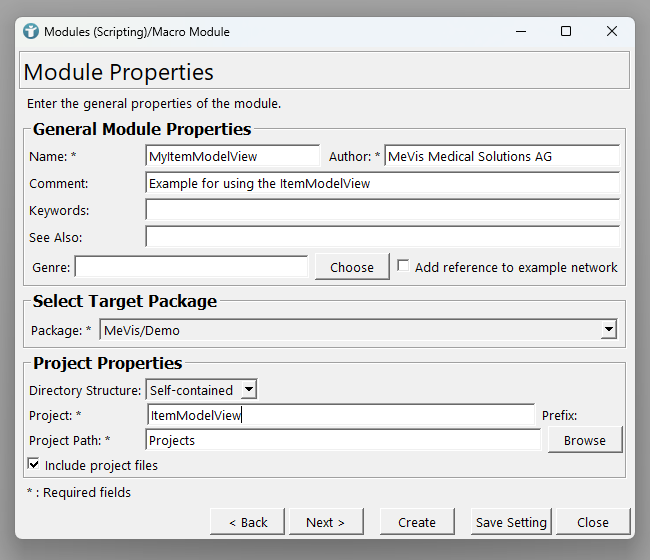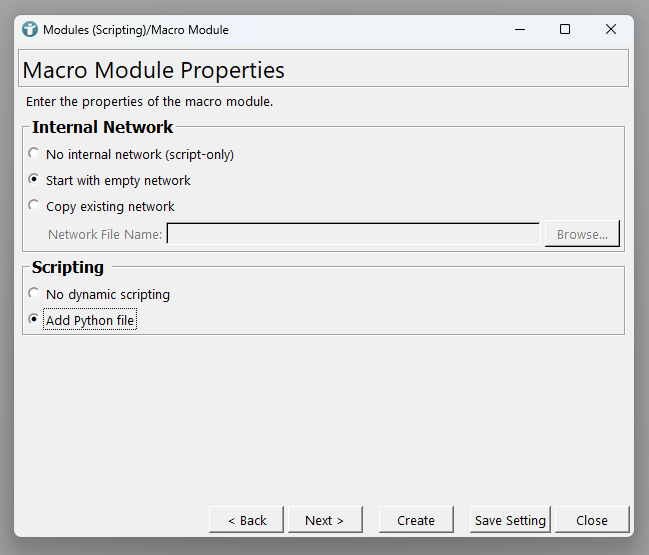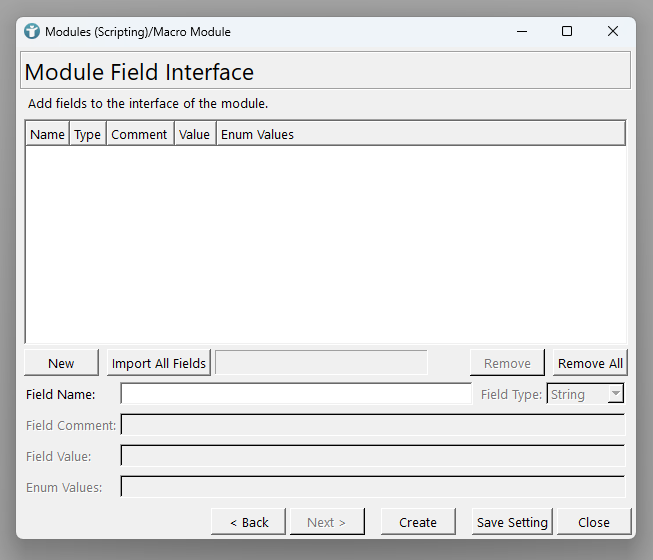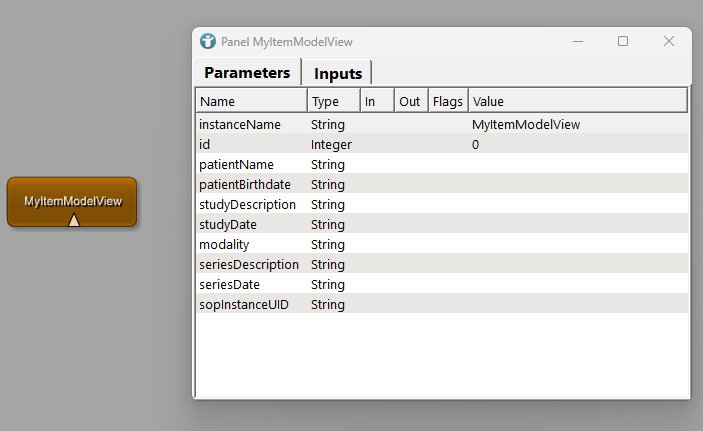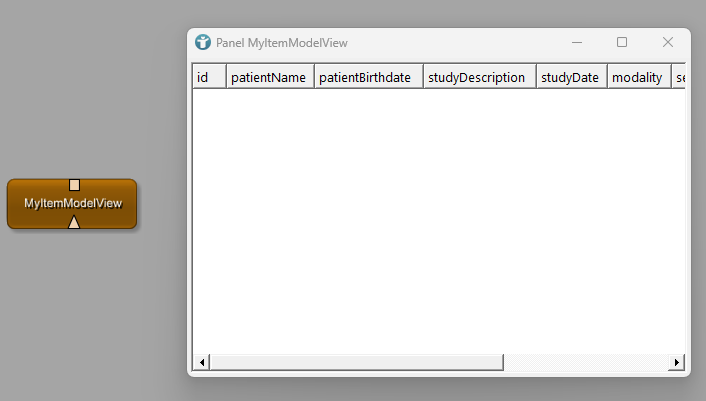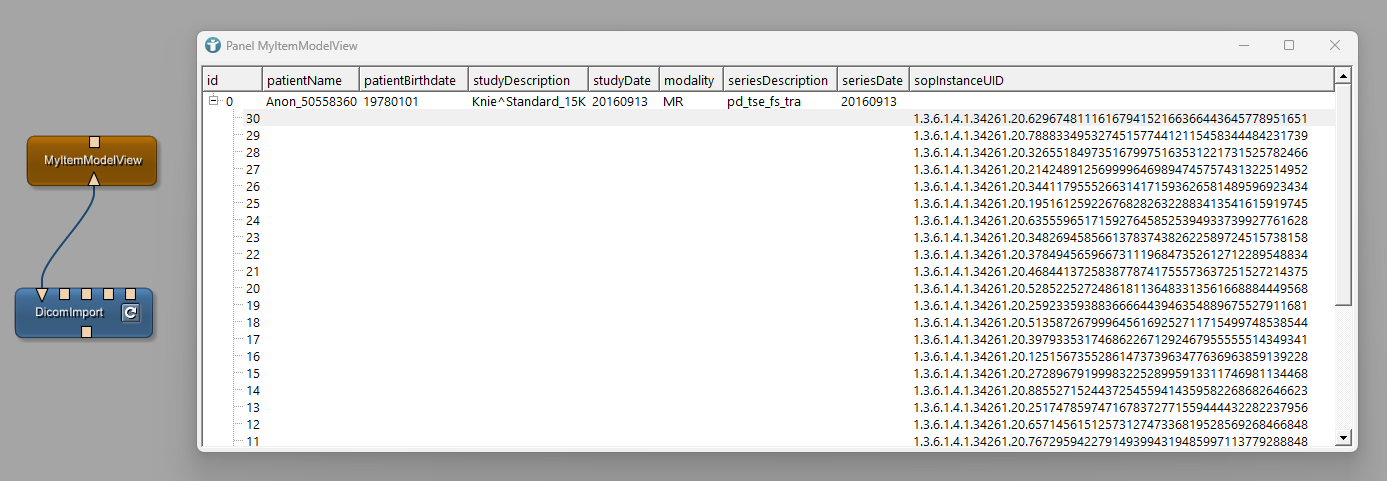Example 7: Creating your own ItemModel by using the ItemModelView
Introduction
In this example, we will show how to use the ItemModelView MDL control to represent an abstract hierarchical item model with generically named attributes. You will see how to select the displayed attributes in the resulting table and how to interact with this table.
We create a macro module that receives an input image and then shows some selected DICOM attributes of this patient in our own ItemModelView.
Prepare your network
Create a Macro Module
Use the Project Wizard via menu entry [
File
→
Run Project Wizard ...
] to create a new macro module named MyItemModelView.
Start with an empty network and add a Python file.
We can leave the Fields empty for now. We can add them in the *.script file.
Click Create

If you cannot find your module via Module Search, reload module cache by clicking the menu item [ Extras → Reload Module Database (Clear Cache) ]
Define the necessary fields
Add your new module MyItemModelView to your workspace. It does not provide a user interface and you do not have any Fields available.
Open the *.script file of your module via right-click

We first define the input for the image.
MyItemModelView.script
Interface {
Inputs {
Field inImage { type = Image }
}
Outputs {}
Parameters {}
}
Then, we define all attributes of the input image we want to use in our ItemModel.
- Patient
- PatientName
- PatientBirthDate
- Study
- StudyDescription
- StudyDate
- Modality
- Series
- SeriesDescription
- SeriesDate
- Image
- SOPInstanceUID
All of them have to be defined as a Field in the Parameters section of the script.
MyItemModelView.script
Interface {
Inputs {
Field inImage { type = Image }
}
Outputs {}
Parameters {
Field id { type = Int }
Field patientName { type = String }
Field patientBirthdate { type = String }
Field studyDescription { type = String }
Field studyDate { type = String }
Field modality { type = String }
Field seriesDescription { type = String }
Field seriesDate { type = String }
Field sopInstanceUID { type = String }
}
}
If you now open your panel, you should see the Input inImage and the just created Fields. The Field id is necessary to identify unique objects in your ItemModel later. In order to make this example easier to understand, we defined all types of the Fields as String. You can also use different types, if you like.
Add the ItemModelView to your panel
We can now add the ItemModelView to our panel and define the columns of the view, that we want to see. Add a Window section to your script file and define it as seen below.
MyItemModelView.script
Window {
Category {
Vertical {
ItemModelView myItemModel {
name = itemModelView
idAttribute = id
Column id {}
Column patientName {}
Column patientBirthdate {}
Column studyDescription {}
Column studyDate {}
Column modality {}
Column seriesDescription {}
Column seriesDate {}
Column sopInstanceUID {}
}
}
}
}
Every Field that we defined in the Parameters section is now used as a column in our view. The Field id has been defined to be the idAttribute. If you now open your panel, MeVisLab will complain that you did not define the Field myItemModel. You have to add a Field with this name to your Parameters section or as an Output Field. We will add an Output Field, so that our model can also be used by other modules, if necessary. The type is MLBase.
MyItemModelView.script
Outputs {
Field myItemModel {
type = MLBase
}
}
Your module now also shows an output MLBase object and the columns you defined for the ItemModelView.
Fill your table with data
We want to get the necessary information from the defined input image inImage. We want the module to update the content whenever the input image changes. Therefore we need a Field Listener calling a Python function whenever the input image changes. Add it to your Commands section.
MyItemModelView.script
Commands {
source = $(LOCAL)/MyItemModelView.py
FieldListener inImage {
command = imageChanged
}
}
Whenever the input image changes, the Python function imageChanged is executed. Right-click on the

Before implementing the Python function, we have to add necessary imports and global parameters.
MyItemModelView.py
from mevis import MLAB
gAttributes = ["patientName", "patientBirthdate", "studyDescription", "studyDate", "modality", "seriesDescription", "seriesDate", "sopInstanceUID"]
gModel = None
gNextId = 0
def getNextId():
global gNextId
gNextId += 1
return gNextId
We need to import mevis.MLAB and we define the attributes of our resulting view.
The unique id is an increasing Integer and we can now initialize our model.
Implement the model
In Python, we have to define some basic classes and functions for our final model. Define a class MyItem which represents a single item. Each item may have children of the same type to provide a hierarchical structure.
MyItemModelView.py
class MyItem:
def __init__(self, parent=None):
self.children = []
self.parent = parent
self.data = {}
Now we implement a very simple and basic model named MyItemModel. Initially we create a new MLBase object using the existing StandardItemModel and define the structure of our items as already done using the attributes.
Some additional functions are necessary to get the root item and the selected index of the model. We also need functions to add and insert items and to clear all items.
MyItemModelView.py
class MyItemModel:
def __init__(self):
self.model = MLAB.createMLBaseObject("StandardItemModel", [["id"] + gAttributes])
self.root = MyItem()
self.map = {}
def makeCurrent(self):
ctx.field("myItemModel").setObject(self.model)
def getRootItem(self):
return self.root
def getSelectedIndex(self):
ids = [int(x) for x in ctx.field("selection").value.split()]
if ids:
return self.model.findFirst("id", ids[0])
else:
return None
def addBefore(self):
index = self.getSelectedIndex()
if index:
parent = self.model.getParent(index)
pos = self.model.getChildPosition(index)
else:
parent = None
pos = 0
self.insertItem(parent, pos, True)
def addChild(self):
parent = self.getSelectedIndex()
pos = self.model.getChildCount(parent)
self.insertItem(parent, pos)
def insertItem(self, parent, pos, updateSelection=False, data=None):
self.model.insertItems(parent, pos, data)
self.map[data["id"]] = data
if updateSelection:
ctx.field("selection").value = str(data["id"])
def updateValues(self):
index = self.getSelectedIndex()
if index:
for attr in gAttributes:
value = ctx.field(attr).value
if value != self.model.getData(index, attr):
self.model.setData(index, attr, value)
def clearAll(self):
self.model.clear()
You can see that the above Python code uses a field selection which contains the ID of the selected item in our table. We have to add this Field to our *.script file, too.
MyItemModelView.script
Interface {
...
Parameters {
...
Field selection { type = String }
...
}
}
Window {
Category {
Vertical {
ItemModelView myItemModel {
...
selectionField = selection
...
}
}
}
}
Fill the model with your data
Now, we can implement the function imageChanged.
MyItemModelView.py
def imageChanged(field: "mevislab.MLABField "):
global gModel, gNextId
gModel = MyItemModel()
gNextId = 0
gModel.makeCurrent()
if field.isValid():
patientName, patientBirthdate, studyDescription, studyDate, modality, seriesDescription, seriesDate, numberOfSlices = _getImageData()
gModel.insertItem(
None,
0,
True,
{
"id": getNextId(),
"patientName": patientName,
"patientBirthdate": patientBirthdate,
"studyDescription": studyDescription,
"studyDate": studyDate,
"modality": modality,
"seriesDescription": seriesDescription,
"seriesDate": seriesDate,
"sopInstanceUID": "",
},
)
tmpSelectedIndex = gModel.getSelectedIndex()
for sliceNumber in range(0, numberOfSlices):
instanceUid = field.getFrameSpecificDicomTag("SOPInstanceUID", sliceNumber)
gModel.insertItem(
tmpSelectedIndex,
0,
True,
{
"id": getNextId(),
"patientName": "",
"patientBirthdate": "",
"studyDescription": "",
"studyDate": "",
"modality": "",
"seriesDescription": "",
"seriesDate": "",
"sopInstanceUID": instanceUid.value(),
},
)
Whenever the image changes, we create a new and empty model (gModel) and reset the next ID (gNextId) to 0. If the image is valid, we get the image data.
MyItemModelView.py
def _getImageData():
imageField = ctx.field("inImage")
patientName = imageField.getDicomTagValueByName("PatientName")
patientBirthdate = imageField.getDicomTagValueByName("PatientBirthDate")
studyDescription = imageField.getDicomTagValueByName("StudyDescription")
studyDate = imageField.getDicomTagValueByName("StudyDate")
modality = imageField.getDicomTagValueByName("Modality")
seriesDescription = imageField.getDicomTagValueByName("SeriesDescription")
seriesDate = imageField.getDicomTagValueByName("SeriesDate")
numberOfSlices = imageField.sizeZ()
return patientName, patientBirthdate, studyDescription, studyDate, modality, seriesDescription, seriesDate, numberOfSlices
The image data is then used to create the root item of our model. We use the selected index of our first entry to walk through all available slices of the image and add the SOP Instance UID of each slice as a child object to our root item.
If you now open the panel of your module, you can already see the results.
The first line shows the information of the patient, the study and the series and each child item represents a single slice of the image.
Interact with your model
We can now add options to interact with the ItemModelView. Open the *.script file of your module and go to the Commands section. We add a FieldListener to our selection field. Whenever the user selects a different item in our view, the Python function itemClicked in the FieldListener is executed.
MyItemModelView.script
Commands {
...
FieldListener selection {
command = itemClicked
}
...
}
Before adding the new Python function, we need a function in our model that returns the values of items from our model. Implement the function getItemByID in our model the following way:
MyItemModelView.py
def getItemByID(self, id):
return self.map[id]
It uses id to find the selected item and returns all values of this item.
Now add the Python function of our FieldListener to your Python script:
MyItemModelView.py
def itemClicked(field: "mevislab.MLABField"):
columnIndex = 8
column = gAttributes[columnIndex - 1]
itemID = int(ctx.field("selection").value)
data = gModel.getItemByID(itemID)[column]
print(f"Click: {data}")
The itemClicked function uses id from the selected item to get the value of column 8 (in this case it is the SOP Instance UID of the image) and prints this value.
The problem is that the Field selection also changes whenever a new item is added to the model. Your debug output is already flooded with SOP Instance UIDs without interaction.
Add another global parameter to your Python script to prevent the FieldListener from executing during the imageChanged event.
MyItemModelView.py
...
gInitializing = False
...
def imageChanged(field: "mevislab.MLABField "):
global gModel, gNextId, gInitializing
gInitializing = True
...
gInitializing = False
def itemClicked(field: "mevislab.MLABField"):
if not gInitializing:
...
While the imageChanged function is executed, the parameter is set to False and the itemClicked function does not print anything.
Summary
- ItemModelViews allow you to define your own abstract hierarchical item model with generically named attributes
- This model can be provided as Output and added to the Panel of your module
- Interactions with the model can be implemented by using a FieldListener.
 Download Archive here.
Download Archive here.


